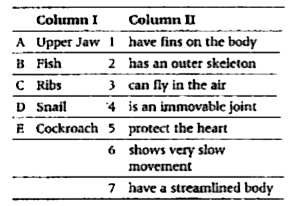Match correctly items in column A with one or more items in column B.
Column A Column B(1)Closest celestial object to the Earth(a)Light year(2)A tailed star(b)Sirius(3)Star which appears stationary(c)Big Bang from the Earth(4)Extremely big unit of distance(d)New Moon(5)Star nearest to the Earth(c)Milky way(6)Brightest star in the night sky(f)Constellations(7)Galaxy to which our solar(g)Comet system belongs.(8)Recognizable patterns in the sky(h)Moon(9)The explosion which led(i)Pole star to the formation of the universe.(10)The phase when the moon is(j)Sun totally invisible.
To solve the matching question between Column A and Column B, we will go through each item in Column A and find the correct match from Column B step by step.
1. Closest celestial object to the Earth:
- The closest celestial object to Earth is the Moon.
- Match: (1) - (h) "Moon"
2. A tailed star:
- A tailed star is known as a Comet.
- Match: (2) - (g) "Comet"
3. Star which appears stationary from the Earth:
- The star that appears stationary from Earth is the Pole Star.
- Match: (3) - (i) "Pole star"
4. Extremely big unit of distance:
- The extremely big unit of distance used in astronomy is a Light year.
- Match: (4) - (a) "Light year"
5. Star nearest to the Earth:
- The star that is nearest to Earth is the Sun.
- Match: (5) - (j) "Sun"
6. Brightest star in the night sky:
- The brightest star visible in the night sky is Sirius.
- Match: (6) - (b) "Sirius"
7. Galaxy to which our solar system belongs:
- Our solar system is part of the Milky Way galaxy.
- Match: (7) - (c) "Milky way"
8. Recognizable patterns in the sky:
- Recognizable patterns formed by stars in the sky are called Constellations.
- Match: (8) - (f) "Constellations"
9. The explosion which led to the formation of the universe:
- The explosion that led to the formation of the universe is known as the Big Bang.
- Match: (9) - (c) "Big Bang"
10. The phase when the moon is totally invisible:
- The phase when the moon is completely invisible is called New Moon.
- Match: (10) - (d) "New Moon"
Final Matches:
- (1) - (h) "Moon"
- (2) - (g) "Comet"
- (3) - (i) "Pole star"
- (4) - (a) "Light year"
- (5) - (j) "Sun"
- (6) - (b) "Sirius"
- (7) - (c) "Milky way"
- (8) - (f) "Constellations"
- (9) - (c) "Big Bang"
- (10) - (d) "New Moon"
- The closest celestial object to Earth is the Moon.
- Match: (1) - (h) "Moon"
- A tailed star is known as a Comet.
- Match: (2) - (g) "Comet"
- The star that appears stationary from Earth is the Pole Star.
- Match: (3) - (i) "Pole star"
- The extremely big unit of distance used in astronomy is a Light year.
- Match: (4) - (a) "Light year"
- The star that is nearest to Earth is the Sun.
- Match: (5) - (j) "Sun"
- The brightest star visible in the night sky is Sirius.
- Match: (6) - (b) "Sirius"
- Our solar system is part of the Milky Way galaxy.
- Match: (7) - (c) "Milky way"
- Recognizable patterns formed by stars in the sky are called Constellations.
- Match: (8) - (f) "Constellations"
- The explosion that led to the formation of the universe is known as the Big Bang.
- Match: (9) - (c) "Big Bang"
- The phase when the moon is completely invisible is called New Moon.
- Match: (10) - (d) "New Moon"
- (1) - (h) "Moon"
- (2) - (g) "Comet"
- (3) - (i) "Pole star"
- (4) - (a) "Light year"
- (5) - (j) "Sun"
- (6) - (b) "Sirius"
- (7) - (c) "Milky way"
- (8) - (f) "Constellations"
- (9) - (c) "Big Bang"
- (10) - (d) "New Moon"
Similar Questions
Knowledge Check
Match the items in Column I with one or more items of Column II.
 AABCDE47,1563,2BABCDE71,53,257,1CABCDE463,257,1DABCDE651,743,2
AABCDE47,1563,2BABCDE71,53,257,1CABCDE463,257,1DABCDE651,743,2Match the items in Column I with one or more items of Column II.
 AABCDE47,1563,2BABCDE71,53,264CABCDE463,257,1DABCDE651,743,2
AABCDE47,1563,2BABCDE71,53,264CABCDE463,257,1DABCDE651,743,2
Match the items in Column I with one or more items of Column II.

View SolutionMatch the Items given in column I with one or more items of column II.

View SolutionMatch the items in column I with those (one or more ) given in column II .

View SolutionName the star nearest to the Earth.
View SolutionMatch the items in column A with those in column B.

View SolutionMatch items in column A with those in column B.

View Solution
